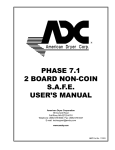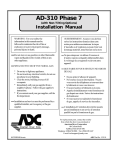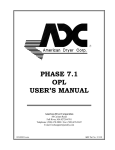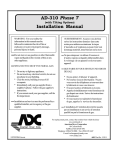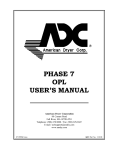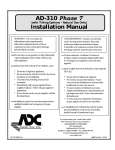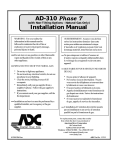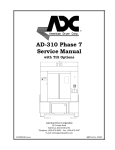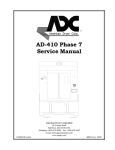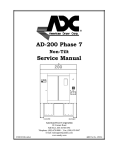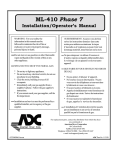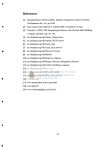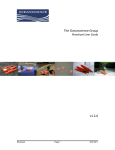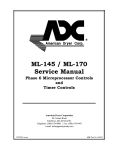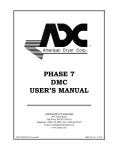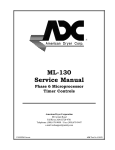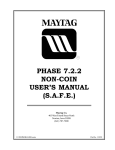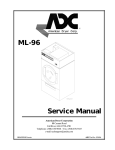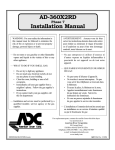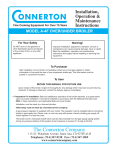Download American Dryer Corp. AD-670 Installation manual
Transcript
AD-670 Installation Manual Phase 7 / Gas Only WARNING: For your safety the information in this manual must be followed to minimize the risk of fire or explosion or to prevent property damage, personal injury or death. AVERTISSEMENT: Assurez-vous de bien suivre les instructions données dans cette notice pour réduire au minimum le risque d’incendie ou d’explosion ou pour éviter tout dommage matériel, toute blessure ou la mort. — Do not store or use gasoline or other flammable vapors and liquids in the vicinity of this or any other appliance. — Ne pas entreposer ni utiliser d’essence ni d’autres vapeurs ou liquides inflammables à proximité de cet appareil ou de tout autre appareil. — WHAT TO DO IF YOU SMELL GAS: • Do not try to light any appliance. • Do not touch any electrical switch; do not use any phone in your building. • Clear the room, building or area of all occupants. • Immediately call your gas supplier from a neighbor’s phone. Follow the gas supplier’s instructions. • If you cannot reach your gas supplier, call the fire department. — Installation and service must be performed by a qualified installer, service agency or the gas supplier. — QUE FAIRE SI VOUS SENTEZ UNE ODEUR DE GAZ: • Ne pas tenter d’allumer d’appareils. • Ne touchez à aucun interrupteur. Ne pas vous servir des téléphones se trouvant dans le bâtiment. • Évacuez la pièce, le bâtiment ou la zone. • Appelez immédiatement votre fournisseur de gaz depuis un voisin. Suivez les instructions du fournisseur. • Si vous ne pouvez rejoindre le fournisseur de gaz, appelez le service des incendies. — L’installation et l’entretien doivent être assurés par un installateur ou un service d’entretien qualifié ou par le fournisseur de gaz. For replacement parts, contact the reseller from which the dryer was purchased or American Dryer Corporation 88 Currant Road Fall River, MA 02720-4781 Telephone: (508) 678-9000 / Fax: (508) 678-9447 E-mail: [email protected] www.amdry.com 103100GS/tcosta ADC Part No. 113049 Retain This Manual In A Safe Place For Future Reference American Dryer Corporation products embody advanced concepts in engineering, design, and safety. If this product is properly maintained, it will provide many years of safe, efficient, and trouble-free operation. ONLY qualified technicians should service this equipment. OBSERVE ALL SAFETY PRECAUTIONS displayed on the equipment or specified in the installation manual included with the dryer. The following “FOR YOUR SAFETY” caution must be posted near the dryer in a prominent location. FOR YOUR SAFETY POUR VOTRE SÉCURITÉ Do not store or use gasoline or other flammable vapors and liquids in the vicinity of this or any other appliance. Ne pas entreposer ni utiliser d’essence ni d’autres vapeurs ou liquides inflammables à proximité de cet appareil ou de tout autre appareil. We have tried to make this manual as complete as possible and hope you will find it useful. ADC reserves the right to make changes from time to time, without notice or obligation, in prices, specifications, colors, and material, and to change or discontinue models. The illustrations included in this manual may not depict your particular dryer exactly. Important For your convenience, log the following information: AD-670 Phase 7 DATE OF PURCHASE _______________________________ MODEL NO. __________________________________________ RESELLER’S NAME _______________________________________________________________________________________ Serial Number(s) ________________________________________________________________________________________ ________________________________________________________________________________________ ________________________________________________________________________________________ Replacement parts can be obtained from your reseller or the ADC factory. When ordering replacement parts from the factory, you can FAX your order to ADC at (508) 678-9447 or telephone your order directly to the ADC Parts Department at (508) 678-9000. Please specify the dryer model number and serial number in addition to the description and part number, so that your order is processed accurately and promptly. “IMPORTANT NOTE TO PURCHASER” Information must be obtained from your local gas supplier on the instructions to be followed if the user smells gas. These instructions must be posted in a prominent location near the dryer. IMPORTANT YOU MUST DISCONTINUE AND LOCKOUT THE ELECTRIC SUPPLYAND THE GAS SUPPLY BEFORE ANY COVERS, GUARDS, OR DOORS ARE REMOVED OR OPENED TO ALLOW ACCESS FOR CLEANING, ADJUSTING, INSTALLATION, OR TESTING OF ANY EQUIPMENT PER OSHA (Occupational Safety and Health Administration) STANDARDS. “Caution: Label all wires prior to disconnection when servicing controls. Wiring errors can cause improper operation.” «Attention: Au moment de l’entretien des commandes, étiquetez tous les fils avant de les débrancher. Des erreurs de câblage peuvent entraîner un fonctionnement inadéquat et dangereux.» CAUTION DRYERS SHOULD NEVER BE LEFT UNATTENDED WHILE IN OPERATION. WARNING CHILDREN SHOULD NOT BE ALLOWED TO PLAY ON OR NEAR THE DRYERS. CHILDREN SHOULD BE SUPERVISED IF NEAR DRYERS IN OPERATION. FOR YOUR SAFETY DO NOT DRY MOP HEADS IN THE DRYER. DO NOT USE DRYER IN THE PRESENCE OF DRY CLEANING FUMES. WARNING UNDER NO CIRCUMSTANCES should the dryer door switches, lint drawer switch, heat safety circuit, or tilt switches ever be disabled. WARNING The dryer must never be operated with any of the back guards, outer tops, or service panels removed. PERSONAL INJURY OR FIRE COULD RESULT. WARNING DRYER MUST NEVER BE OPERATED WITHOUT THE LINT DRAWERS IN PLACE, EVEN IF AN EXTERNAL LINT COLLECTION SYSTEM IS USED. IMPORTANT PLEASE OBSERVE ALL SAFETY PRECAUTIONS displayed on the equipment or specified in the installation manual included with the dryer. Dryers must not be installed or stored in an area where it will be exposed to water or weather. The wiring diagram for the dryer is located in the left front electrical control cabinet. Table of Contents SECTION I IMPORTANT INFORMATION ............................................................................ 3 A. Receiving and Handling ........................................................................................................... 3 B. Safety Precautions .................................................................................................................. 4 SECTION II SPECIFICATIONS AND DIMENSIONS ............................................................. 6 A. Specifications ......................................................................................................................... 6 B. Dimensions ............................................................................................................................ 7 SECTION III INSTALLATION PROCEDURES ......................................................................... 8 A. B. C. D. E. F. G. H. I. Location Requirements ........................................................................................................... 8 Fresh Air Supply Requirements ............................................................................................... 9 Exhaust Requirements........................................................................................................... 10 Electrical Requirements......................................................................................................... 13 Gas Requirements ................................................................................................................ 15 Compressed Air Requirements .............................................................................................. 18 Preoperational Tests ............................................................................................................. 19 Preparation For Operation/Start-Up ...................................................................................... 21 Shut Down Instructions ......................................................................................................... 22 SECTION IV ROUTINE MAINTENANCE ............................................................................... 23 A. Cleaning .............................................................................................................................. 23 B. Adjustments......................................................................................................................... 25 C. Lubrication .......................................................................................................................... 25 SECTION V SERVICE/PARTS INFORMATION.................................................................... 26 A. Service ................................................................................................................................ 26 B. Parts ................................................................................................................................... 26 SECTION VI WARRANTY INFORMATION ............................................................................ 27 A. Returning Warranty Cards ..................................................................................................... 27 B. Warranty ............................................................................................................................. 27 C. Returning Warranty Parts ...................................................................................................... 27 SECTION VII DATA LABEL INFORMATION .......................................................................... 29 A. Data Label........................................................................................................................... 29 SECTION VIII GAS TRAIN AND BURNER DESCRIPTION AND OPERATION ................. 31 A. Pilot Gas Supply Line ........................................................................................................... 31 B. Main Gas Supply Line .......................................................................................................... 33 C. Lo-Fire Gas Supply Line Loop ............................................................................................. 34 SECTION IX COMPONENT SYSTEM DESCRIPTIONS ...................................................... 35 A. B. C. D. E. Basket (Tumbler) Drive System ............................................................................................. 35 Basket (Tumbler) ................................................................................................................. 36 Blower System..................................................................................................................... 36 Air Jet System ..................................................................................................................... 36 Safety Devices ..................................................................................................................... 36 SECTION X PHASE 7 OPL SYSTEM DIAGNOSTICS.......................................................... 38 A. Diagnostic (L.E.D. Display) Fault Messages ........................................................................... 38 B. I/O Board Input and Output L.E.D. Indicators........................................................................ 40 SECTION XI TROUBLESHOOTING ........................................................................................ 45 SECTION XII OPTIONAL SPRINKLER SYSTEM COMPONENTS ..................................... 52 SECTION I IMPORTANT INFORMATION A. RECEIVING AND HANDLING The dryer is shipped in three (3) pieces with protective stretch wrap, protective cardboard corners, and top covers as a means of preventing damage in transit. Upon delivery, the individual pieces and/or packaging, and wooden skids should be visually inspected for shipping damage. If any damage whatsoever is noticed, inspect further before delivering carrier leaves. Dryers damaged in shipment: 1. ALL dryers should be inspected upon receipt and before they are signed for. 2. If there is suspected damage or actual damage, the trucker’s receipt should be so noted. 3. If the dryer is damaged beyond repair, it should be refused. Those dryers, which were not damaged in a damaged shipment, should be accepted, but the number received and the number refused must be noted on the receipt. 4. If you determine that the dryer was damaged after the trucker has left your location, you should call the delivering carrier’s freight terminal immediately and file a claim. The freight company considers this concealed damage. This type of freight claim is very difficult to get paid and becomes extremely difficult when more than a day or two passes after the freight was delivered. It is your responsibility to file freight claims. Dryer/parts damaged in transit cannot be claimed under warranty. 5. Freight claims are the responsibility of the consignee, and ALL claims must be filed at the receiving end. ADC assumes no responsibility for freight claims or damages. 6. If you need assistance in handling the situation, please contact the ADC Traffic Manager at (508) 678-9000. IMPORTANT: The dryer must be transported and handled in an upright position at ALL times. 3 B. SAFETY PRECAUTIONS WARNING: For your safety, the information in this manual must be followed to minimize the risk of fire or explosion or to prevent property damage, personal injury, or loss of life. WARNING: The dryer must never be operated with any of the safety guards, service panels, or service doors removed or open. PERSONAL INJURY OR FIRE COULD RESULT. 1. DO NOT store or use gasoline or other flammable vapors and liquids in the vicinity of this or any other appliance. 2. Purchaser/user should consult the local gas supplier for proper instructions to be followed in the event the user smells gas. The instructions should be posted in a prominent location. 3. WHAT TO DO IF YOU SMELL GAS... a. DO NOT try to light any appliance. b. DO NOT touch any electrical switch. c. DO NOT use any phone in your building. d. Clear the room, building, or area of ALL occupants. e. Immediately call your gas supplier from a neighbor’s phone. Follow the gas supplier’s instructions. f. If you cannot reach your gas supplier, call the fire department. 4. Installation and service must be performed by a qualified installer, service agency, or gas supplier. 5. Dryer(s) must be exhausted to the outdoors. 6. Although ADC produces a very versatile dryer, there are some articles that, due to fabric composition or cleaning method, should not be dried in it. WARNING: Dry only water washed fabrics. DO NOT dry articles spotted or washed in dry cleaning solvents, a combustible detergent, or “all purpose” cleaner. EXPLOSION COULD RESULT. WARNING: DO NOT dry rags or articles coated or contaminated with gasoline, kerosene, oil, paint, or wax. EXPLOSION COULD RESULT. WARNING: DO NOT dry mop heads. Contamination by wax or flammable solvents will create a fire hazard. 4 WARNING: DO NOT use heat for drying articles that contain plastic, foam, sponge rubber, or similarly textured rubberlike materials. Drying in a heated basket (tumbler) may damage plastics or rubber and may be a fire hazard. 7. A program should be established for the inspection and cleaning of lint in the burner area, exhaust ductwork, and area around the back of the dryer. The frequency of inspection and cleaning can best be determined from experience at each location. WARNING: The collection of lint in the burner area and exhaust ductwork can create a potential fire hazard. 8. For personal safety, the dryer must be electrically grounded in accordance with local codes and/or the National Electrical Code ANSI/NFPA NO. 70-LATEST EDITION or in Canada, the Canadian Electrical Codes Parts 1 & 2 CSA C22.1-1990 or LATEST EDITION. NOTE: Failure to do so will VOID THE WARRANTY. 9. UNDER NO CIRCUMSTANCES should the dryer door switches, lint drawer switch, heat safety circuit, or tilt switches ever be disabled. WARNING: PERSONAL INJURY OR FIRE COULD RESULT. 10. This dryer is not to be used in the presence of dry cleaning solvents or fumes. 11. Remove articles from the dryer as soon as the drying cycle has been completed. WARNING: Articles left in the dryer after the drying and cooling cycles have been completed can create a fire hazard. 12. READ AND FOLLOW ALL CAUTION AND DIRECTION LABELS ATTACHED TO THE DRYER. 13. For safety, proper operation, and optimum performance, the dryer must not be operated with a load less than sixty-six percent (66%) 442 lbs (200 kg) of its rated capacity. WARNING: YOU MUST DISCONTINUE AND LOCKOUT THE ELECTRIC SUPPLY AND THE GAS SUPPLY BEFORE ANY COVERS, GUARDS, OR DOORS ARE REMOVED OR OPENED TO ALLOW ACCESS FOR CLEANING, ADJUSTING, INSTALLATION, OR TESTING OF ANY EQUIPMENT PER OSHA (Occupational Safety and Health Administration) STANDARDS. 5 SECTION II SPECIFICATIONS AND DIMENSIONS A. SPECIFICATIONS 303.9 kg 198.8 cm 233.7 cm 7.25 cu m 2 x 3.73 kW 18.7 kW 132.1 cm 0.42/0.54 cmh 1/2" F.N.P.T. 1" F.N.P.T. 208-480v / 3Ø / 3,4w / 50/60 Hz 554,400 kcal/hr 2,200,000 Btu/hr 4,173 kg 9,200 lb 368 cmm 13,000 cfm 2" F.N.P.T. 670 lb 78-1/4" 92" 256 cu ft 2 x 5 hp 25 hp 52" 15/19 cfh Gas Maximum Capacity (Dry Weight) Basket Diameter Basket Depth Basket Volume Blower Motor Basket Motor Door Sill Height, Level Compressed Air Volume (1-way / 2-way tilt) Compressed Air Connection S.A.F.E. Water Connection* Voltage Available Heat Input Approx. Shipping Weight Airflow Inlet Pipe Connection** 061103 * Water supply must be 40 psi +/- 20 psi (2.75 bar +/- 1.37 bar) for S.A.F.E. system to operate properly . ** Size of piping to dryer varies with installation conditions. Contact factory for assistance. NOTE: ADC reserves the right to make changes in specifications at any time without notice or obligation. 6 AD-670 1 Door Tilting/2 Door Tilting B. DIMENSIONS NOTE: ADC reserves the right to make changes in specifications at any time without notice or obligation. 7 SECTION III INSTALLATION PROCEDURES Installation should be performed by competent technicians in accordance with local and state codes. In the absence of these codes, the installation must conform to applicable American National Standards: ANSI Z223.1LATEST EDITION (National Fuel Gas Code) or ANSI/NFPA NO. 70-LATEST EDITION (National Electrical Code) or in Canada, the installation must conform to applicable Canadian Standards: CAN/CGA-B149.1-M91 (Natural Gas) or CAN/CGA-B149.2-M91 (Liquid Propane [L.P.] Gas) or LATEST EDITION (for General Installation and Gas Plumbing) or Canadian Electrical Codes Parts 1 & 2 CSA C22.1-1990 or LATEST EDITION (for Electrical Connections). A. LOCATION REQUIREMENTS Before installing the dryer, be sure the location conforms to local codes and ordinances. In the absence of such codes or ordinances the location must conform with the National Fuel Gas Code ANSI.Z223.1 LATEST EDITION, or in Canada, the installation must conform to applicable Canadian Standards: CAN/CGA-B149.1M91 (Natural Gas) or CAN/CGA-B149.2-M91 (L.P. Gas) or LATEST EDITION (for General Installation and Gas Plumbing). 1. The dryer must be installed on a sound level floor capable of supporting its weight. Carpeting must be removed from the floor area that the dryer is to rest on. IMPORTANT: “The dryer must be installed on noncombustible floors only.” 2. The dryer must not be installed or stored in an area where it will be exposed to water and/or weather. 3. The dryer is for use in noncombustible locations. 4. Provisions for adequate air supply must be provided as noted in this manual (refer to Fresh Air Supply Requirements in Section B). 5. Dryer must be exhausted to the outdoors as noted in this manual (refer to Exhaust Requirements in Section C). 6. Dryer must be located in an area where correct exhaust venting can be achieved as noted in this manual (refer to Exhaust Requirements in Section C). IMPORTANT: Dryer should be located where a minimum amount of exhaust duct will be necessary. 7. The dryer must be installed with a proper exhaust duct connection to the outside. 8. The dryer must be installed with provisions for adequate combustion and make-up air supply. CAUTION: This dryer produces combustible lint and must be exhausted to the outdoors. Every 6 months, inspect the exhaust ducting and remove any lint build up. 8 B. FRESH AIR SUPPLY REQUIREMENTS When the dryer is operating, it draws in room air, heats it, passes this air through the basket (tumbler), and exhausts it out of the building. Therefore, the room air must be continually replenished from the outdoors. If the make-up air is inadequate, drying time and efficiency will be adversely affected. Ignition problems and sail switch “fluttering” problems may result, as well as premature motor failure from overheating. Air supply (make-up air) must be given careful consideration to assure proper performance of each dryer. An unrestricted source of air is necessary for each dryer. As a general rule, an unrestricted air entrance from the outdoors (atmosphere) of a minimum of 16 square feet (1.48 square meters) is required for each dryer for proper combustion. To compensate for the use of registers or louvers used over the openings, this make-up air area must be increased by approximately thirty-three percent (33%). Make-up air openings should not be located in an area directly near where exhaust vents exit the building. It is not necessary to have a separate make-up air opening for each dryer. Common make-up air openings are acceptable. However, they must be set up in such a manner that the make-up air is distributed equally to ALL the dryers. The dryer must be installed with provisions for adequate combustion and make-up air supply. Allowances must be made for remote or constricting passageways or where dryers are located at excessive altitudes or predominantly low pressure areas. 9 IMPORTANT: Make-up air must be provided from a source free of dry cleaning solvent fumes. Make-up air that is contaminated by dry cleaning solvent fumes will result in irreparable damage to the motors and other dryer components. NOTE: Component failure due to dry cleaning solvent fumes will VOID THE WARRANTY. C. EXHAUST REQUIREMENTS IMPORTANT: Each AD-670 must be individually exhausted to the outdoors. 1. General Exhaust Ductwork Information Exhaust ductwork should be designed and installed by a qualified professional. Improperly sized ductwork will create excessive back pressure which results in slow drying, increased use of energy, overheating of the dryer, and shutdown of the burner by the airflow (sail) switches, burner hi-limits, or basket (tumbler) hi-heat thermostats. The dryer must be installed with a proper exhaust duct connection to the outside. CAUTION: This dryer produces combustible lint and must be exhausted to the outdoors. CAUTION: IMPROPERLY SIZED OR INSTALLED EXHAUST DUCTWORK CAN CREATE A POTENTIAL FIRE HAZARD. NOTE: When a dryer is exhausted separately, it is not recommended that a back draft damper be installed. The ductwork should be laid out in such a way that the ductwork travels as directly as possible to the outdoors with as few turns as possible. The shape of the ductwork is not critical so long as the minimum cross-sectional area is provided. It is suggested that the use of 90º turns in ducting be avoided; use 30º and/or 45º angles instead. The radius of the elbow should preferably be 1-1/2 times the diameter of the duct. The dryer comes with a 24-inch (60.96 cm) diameter exhaust duct connection. The plant’s exhaust duct must be at least 24-inches (60.96 cm) in diameter or for a rectangular duct have a cross-sectional area of 452 square inches (2916 square centimeters). The shape of the ductwork is not critical so long as the minimum cross-sectional area is provided. It is suggested that the use of 90º turns be avoided; use 45º angles instead. The radius of the elbows should preferably be 1-1/2 times the width or diameter of the duct. Excluding basket (tumbler)/dryer elbow connections or elbows used for outside protection from the weather, no more than two (2) elbows should be used in the exhaust duct run. If more than two (2) elbows are used, the cross-sectional area of the ductwork must be increased. ALL ductwork should be smooth inside with no projections from sheet metal screws or other obstructions, which will collect lint. When adding ducts, the duct to be added should overlap the duct to which it is to be connected. ALL ductwork joints must be taped to prevent moisture and lint from escaping into the building. Inspection doors should be installed at strategic points in the exhaust ductwork for periodic inspection and cleaning of lint from the ductwork. 10 IMPORTANT: Exhaust back pressure measured by a Magnehelic in the exhaust duct must be no less than 0 and must not exceed 1.0 inch (2.48 mb) of water column (W.C.). NOTE: When the exhaust ductwork passes through a wall, ceiling, or roof made of combustible materials, the opening must be 2-inches (5.08 cm) larger than the duct (all the way around). The duct must be centered within this opening. a. Outside Ductwork Protection 1) To protect the outside end of the horizontal ductwork from the weather, a 90º elbow turned downward should be installed where the exhaust exits the building. If the ductwork travels vertically up through the roof, it should be protected from the weather by using a 180º turn to point the opening downward. In either case, allow at least twice the diameter of the duct between the duct opening and the nearest obstruction. IMPORTANT: DO NOT use screens, louvers, or caps on the outside opening of the exhaust ductwork. 11 12 D. ELECTRICAL REQUIREMENTS It is your responsibility to have ALL electrical connections made by a properly licensed and competent electrician to assure that the electrical installation is adequate and conforms to local and state regulations or codes. In the absence of such codes, ALL electrical connections, materials, and workmanship must conform to the applicable requirements of the National Electrical Code ANSI/NFPA NO. 70-LATEST EDITION or in Canada, the Canadian Electrical Codes Parts 1 & 2 CSA C22.1-1990 or LATEST EDITION. IMPORTANT: Failure to comply with these codes or ordinances, and/or the requirements stipulated in this manual can result in personal injury or component failure. NOTE: Component failure due to improper installation will VOID THE WARRANTY. It is required that a separate circuit servicing each basket (tumbler) be provided. The dryer must be connected with copper wire only. DO NOT use aluminum wire, which could cause a fire hazard. NOTE: The use of aluminum wire will VOID THE WARRANTY. 1. Electrical Service Specifications GAS ELECTRICAL SERVICE SPECIFICATIONS (PER DRYER) IMPORTANT: 208 VAC AND 230/240 VAC ARE NOT THE SAME. When ordering, specify exact voltage. NOTES: When fuses are used they must be dual element, time delay, current limiting, class RK1 or RK5 ONLY. Calculate/determine correct fuse value, by applying either local and/or National Electrical Codes to listed appliance amp draw data. Circuit breakers are thermal-magnetic (industrial) motor curve type ONLY. For others, calculate/verify correct breaker size according to appliance amp draw rating and type of breaker used. Circuit breakers for 3-phase (3ø) dryers must be 3-pole type. A. B. C. SERVICE VOLTAGE PHASE 208 230 230 380 400 416 460 480 3ø 3ø 3ø 3ø 3ø 3ø 3ø 3ø WIRE SERVICE 3/4 3 3 3/4 3/4 3/4 3 3 APPROX. AMP DRAW 60 Hz 50 Hz 118.1 108.7 — — — — 58.9 59.3 — — — 66.8 67.4 65.4 — — CIRCUIT BREAKER 150 150 — 90 90 90 90 90 IMPORTANT: THE DRYER MUST BE CONNECTED TO THE ELECTRIC SUPPLY SHOWN ON THE DATA LABEL THAT IS AFFIXED TO THE LEFT SIDE OF THE MAIN ELECTRICAL CABINET LOCATED IN THE RIGHT HAND ELECTRICAL ENCLOSURE. 13 WARNING: 208 VAC AND 240 VAC ARE NOT THE SAME. Any damage done to the dryer components due to improper voltage connections will automatically VOID THE WARRANTY. NOTE: ADC reserves the right to make changes in specifications at any time without notice or obligation. 2. Electrical Connections NOTE: A wiring diagram is included with each dryer and is located in the blueprint pocket inside the left hand side control cabinet. The main electrical input connections to the dryer are the 3-phase (3ø) power leads (L1, L2, and L3), GROUND, and in the case of 4 wire service, the Neutral. These electrical connections are made at the power distribution block located in the right side base electrical enclosure. If the dryer has an optional sprinkler circuit then a separate single-phase (1ø) source must be supplied to the sprinkler circuit at the nameplate voltage. These connections are made at the power distribution block located in the right side base electrical enclosure. The main electrical 3-phase (3ø) connections (L1, L2, and L3) and the optional single-phase (1ø) connection must be provided and installed in accordance with state and local codes. In ALL cases, a strain relief must be used where the wire(s) enter the dryer electrical service (relay) box. NOTE: A CIRCUIT SERVICING EACH DRYER MUST BE PROVIDED. 3. Main Grounding A ground (earth) connection must be provided and installed in accordance with state and local codes. In the absence of these codes, grounding must conform to applicable requirements of the National Electrical Code ANSI/NFPA NO. 70-LATEST EDITION, or in Canada, the installation must conform to applicable Canada Standards: Canadian Electrical Codes Parts 1 & 2 CSA C22.1-1990 or LATEST EDITION. The ground connection may be to a proven earth ground at the location service panel. NOTE: A grounding connection (terminal block) is provided in the dryer in the base electrical junction box. For added personal safety, when possible, it is suggested that a separate ground wire (sized per local codes) be connected from the ground connection of the dryer to a cold water pipe. DO NOT ground to a gas or hot water pipe. The grounded cold water pipe must have metal to metal connections ALL the way to electrical ground. If there are any nonmetallic interruptions, such as a meter, pump, plastic, rubber, or other insulating connectors, they must be jumped out with no. 4 copper wire and securely clamped to bare metal at both ends. IMPORTANT: For personal safety and proper operation, the dryer must be grounded. For proper operation of the microprocessor controller (computer), an earth (zero) ground is required. NOTE: Grounding via metallic electrical conduit (pipe) is not recommended. 14 E. GAS REQUIREMENTS It is your responsibility to have ALL plumbing connections made by a qualified professional to assure that the gas plumbing installation is adequate and conforms to local and state regulations or codes. In the absence of such codes, ALL plumbing connections, materials, and workmanship must conform to the applicable requirements of the National Fuel Gas Code ANSI Z223.1-LATEST EDITION, or in Canada, the Canadian Installation Codes CAN/CGA-B149.1-M91 (Natural Gas) or CAN/CGA-B149.2-M91 (Liquid Propane [L.P.] Gas) or LATEST EDITION. IMPORTANT: Failure to comply with these codes or ordinances, and/or the requirements stipulated in this manual, can result in personal injury and improper operation of the dryer. The dryer and its individual shutoff valves must be disconnected from the gas supply piping system during any pressure testing of that system at test pressures in excess of 1/2 psig (3.5 kPa). The dryer must be isolated from the gas supply piping system by closing its individual manual shutoff valve during any pressure test of the gas supply system at test pressures equal to or less than 1/2 psig (3.5 kPa). IMPORTANT: Failure to isolate or disconnect the dryer from gas supply as noted can cause irreparable damage to the gas valve, which will VOID THE WARRANTY. WARNING: FIRE OR EXPLOSION COULD RESULT. 1. Gas Supply The gas dryer installation must meet the American National Standard...National Fuel Gas Code ANSI Z223.1-LATEST EDITION, or in Canada, the Canadian Installation Codes CAN/CGA-B149.1 M91 (Natural Gas) or CAN/CGA-B149.2-M91 (L.P. Gas) or LATEST EDITION, as well as local codes and ordinances and must be done by a qualified professional. NOTE: Undersized gas piping will result in ignition problems, slow drying, increased use of energy, and can create a safety hazard. The dryer must be connected to the type of heat/gas indicated on the dryer data label affixed to the left side of the main electrical cabinet located in the right hand electrical enclosure. If this information does not agree with the type of gas available, DO NOT operate the dryer. Contact the reseller who sold the dryer or contact the ADC factory. IMPORTANT: Any adjustments to the gas train must be made by a qualified professional. The input ratings shown on the dryer data label are for elevations up to 2,000 feet (609.6 meters), unless elevation requirements of over 2,000 feet (609.6 meters) were specified at the time the dryer order was placed with the factory. The adjustment or conversion of dryers in the field for elevations over 2,000 feet (609.6 meters) is made by changing the adjustments on the gas train. If adjustments are necessary, contact the reseller who sold the dryer or contact the ADC factory. 15 2. Technical Gas Data a. Gas Specifications TYPE OF GAS Natural Liquid Propane Pressure @ Hi-Fire Gas Valve* 3.5 inches W.C. 8.7 mb 6.5 inches W.C. 16.17 mb Pressure @ Gauge P1* 3.5 inches W.C. 8.7 mb 6.5 inches W.C. 16.17 mb 11.0 inches W.C. 27.4 mb Pressure Into Internal Regulator 6.0 - 12.0 inches W.C. 14.92 mb - 29.9 mb Shaded areas are stated in metric equivalents * Measured at the gas valve pressure tap when the gas valve is on. b. Gas Connections Run a 2-inch gas pipe from the main gas header to the dryer. There is a 2-inch gas pipe connection at the bottom of the dryer base. Inlet Connection ...................2” F.P.T. BTU/hr input (per dryer) ......2,200,000 BTU/hr (554,400 kcal/hr) 16 3. Piping /Connections ALL components/materials must conform to National Fuel Gas Code Specifications ANSI Z223.1-LATEST EDITION, or in Canada, CAN/CGA-B149.1-M91 (Natural Gas) or CAN/CGA-B149.2-M91 (Liquid Propane [L.P.] Gas) or LATEST EDITION (for General Installation and Gas Plumbing), as well as local codes and ordinances and must be done by a qualified professional. It is important that gas pressure regulators meet applicable pressure requirements, and that gas meters be rated for the total amount of ALL the appliance BTUs being supplied. The dryer is provided with a 2” N.P.T. inlet pipe connection located at the right side of the base of the dryer. For ease in servicing, the gas supply line of each dryer must have its own shutoff valve. The size of the main gas supply line (header) will vary depending on the distance this line travels from the gas meter or, in the case of L.P. gas, the supply tank, other gas operated appliances on the same line, etc. Specific information regarding supply line size should be determined by the gas supplier. NOTE: Undersized gas supply piping can create a low or inconsistent pressure, which will result in erratic operation of the burner ignition system. 17 Consistent gas pressure is essential at ALL gas connections. It is recommended that a 2-inch (5.08 cm) pipe gas loop be installed in the supply line servicing a bank of dryers. An in-line pressure regulator must be installed in the gas supply line (header) if the (natural) gas pressure exceeds 12.0 inches (29.9 mb) of water column (W.C.) pressure. An 1/8” N.P.T. plugged tap, accessible for a test gauge connection, must be installed in the main gas supply line immediately upstream of each dryer. IMPORTANT: Pipe joint compounds that resist the action of natural gas and liquid propane (L.P.) gas must be used. IMPORTANT: Test ALL connections for leaks by brushing on a soapy water solution (liquid detergent works well). WARNING: NEVER TEST FOR LEAKS WITH A FLAME!!! ALL components/materials must conform to National Fuel Gas Code Specifications ANSI Z223.1-LATEST EDITION, or in Canada, CAN/CGA-B149.1-M91 (Natural Gas) or CAN/CGA-B149.2-M91 (L.P. Gas) or LATEST EDITION (for General Installation and Gas Plumbing), as well as local codes and ordinances and must be done by a qualified professional. It is important that gas pressure regulators meet applicable pressure requirements, and that gas meters be rated for the total amount of ALL the appliance BTUs being supplied. IMPORTANT: The dryer and its individual shutoff valve must be disconnected from the gas supply piping system during any pressure testing of that system at test pressures in excess of 1/2 psig (3.5 kPa). NOTE: The dryer must be isolated from the gas supply piping system by closing its individual manual shutoff valve during any pressure test of the gas supply system at test pressures equal to or less than 1/2 psig (3.5 kPa). F. COMPRESSED AIR REQUIREMENTS The AD-670 requires compressed air to tilt the dryer, open and close the load doors, clean lint from the fan, and actuate the sprinkler valve. The dryer cannot operate without a supply of compressed air. Each dryer must be supplied with 13 cfh (0.368 cmh) of clean, dry, and regulated compressed air at a pressure of 80 PSI ± 10 PSI (5.51 bars ± 0.68 bars). Failure to meet these requirements can cause premature failure of components and will VOID THE WARRANTY. The 1/2” F.P.T. compressed air connection can be found in the base at the rear of the dryer. WARNING: Compressed air supply to the dryer must remain on at ALL times for the sprinkler to be operational. 18 G. PREOPERATIONAL TESTS ALL dryers are thoroughly tested and inspected before leaving the factory. However, a preoperational test should be performed before the dryer is publicly used. It is possible that adjustments have changed in transit or due to marginal location (installation) conditions. 1. Turn on electric power to the dryer. 2. Make sure the loading doors are closed and the lint drawers are closed. 3. Make sure “green” power button is in and illuminated. 4. Microprocessor controller (computer) system operational test - to start the dryer... a. Display will read “READY.” b. Press “D” (preprogrammed) cycle key on the keyboard (touch pad). 5. The dryer will then start. (i.e., blower, basket [tumbler] and heat.) 6. The light emitting diode (L.E.D.) display will read MANUAL DRYING CYCLE D, 40:00 MIN REMAIN. NOTE: Press the “UP ARROW” to view the basket (tumbler) temperature at any time. NOTE: The dryer can be stopped at any time by pressing the “STOP/CLEAR” O key. If the temperature is above the Cool Down set point when the “STOP/CLEAR” is pressed, the dryer will go into a Cool Down cycle followed by a Wrinkle Guard cycle. If the “STOP/ CLEAR” key is pressed again at this point the cycle that was in progress will be canceled and returned to the “READY” state. If the temperature is below the Cool Down set point, the cycle that was in progress will be canceled, and go to Wrinkle Guard. 7. When the programmed drying time has expired, the Phase 7 OPL microprocessor controller (computer) will proceed into the Cool Down Cycle (Mode). 8. Once the Cool Down cycle begins at the end of the heat cycle the L.E.D. display will read COOL DOWN TEMP ___/___MINUTE REMAINING. At the end of the heat cycle the dryer will shut off the heat, and continue the fan and basket (tumbler) until the Cool Down Time, or temperature is reached. 9. Once the Cool Down cycle is completed the Phase 7 OPL microprocessor controller (computer) will proceed into the Wrinkle Guard cycle. The Audio Alert tone will sound for (the amount set in Audio Alert ON Time). The L.E.D. display will read “WRINKLE GUARD.” The times are fixed at 2 minutes OFF, 2 minutes ON for a maximum time of 99 minutes. These times are not programmable. During the ON time, the blower (fan) and the basket (tumbler) will start to rotate (without heat for 2 minutes). The Phase 7 OPL microprocessor controller (computer) will repeat this process until the Maximum Wrinkle Guard On Time has expired (99 minutes). The L.E.D. display will then read “CYCLE DONE” and lockout the dryer functions until the doors are opened. It will then return to “READY.” 19 NOTE: Mechanical functions of the dryer are not allowed during the ON time. The blower (fan) must be OFF to perform mechanical functions. However the “STOP/CLEAR” key may be pressed at any time to end the Wrinkle Guard cycle. Mechanical functions of the dryer are allowed during the OFF time. NOTE: Dryer can be stopped at any time by opening the main door or by pressing the “STOP/ CLEAR” key. There is no pause function. NOTE: Pressing keyboard (touch pad) key “A,” “B,” “C,” “D,” or “F” will also start the dryer. The six (6) preprogrammed drying cycles (“A” thru “F”) have been stored in the microprocessor controller’s (computer’s) memory. Refer to the User’s Manual supplied with the dryer for these preprogrammed cycles. 10. Check to insure that the basket (tumbler) starts in the clockwise (CW) direction. Additionally, check the direction of the blower motor to insure that it rotates in the counterclockwise (CCW) direction as viewed from the left side of the dryer. If it does, the phasing is correct. If the phasing is incorrect, reverse two (2) of the leads at L1, L2, or L3 of the power supply connections made to the dryer. IMPORTANT: Dryer blower motor and impellor/fan shaft as viewed from the left side of the dryer must turn in the counterclockwise (CCW) direction, otherwise the dryer efficiency will be drastically reduced, and premature component failure can result. 11. Heat Circuit Operational Test a. Gas Models 1) When the dryer is first started (during initial start-up), the burners have a tendency not to ignite on the first attempt. This is because the gas supply piping is filled with air, so the dryer may have to be stopped and restarted several times for this air to be purged from the lines. 2) The dryer has one (1) burner that is controlled by a burner system module with Direct Spark Ignition (DSI). There is one (1) spark ignition assembly (spark plug) and two (2) flame-probe assemblies. If pilot ignition is not established after the first attempt, the heat circuit will be locked out by the burner control module, until it has been manually reset. To reset the burner monitoring system, press the black pilot test (reset) button on the burner control module. NOTE: During the purging period, verify that ALL gas shutoff valves are open. 3) Once ignition is established, a gas pressure test should be taken at the gas valve pressure tap of the dryer to assure that the water column (W.C.) pressure is correct and consistent. 20 12. Make a complete operational check of ALL safety-related circuits (i.e., lint drawer, door, and sail switches on gas models). 13. A reversing basket (tumbler) should never be operated with less than a 442 lb (200 kg) load (dry weight). The size of the load will affect the coast-down and dwell (stop) times. The basket (tumbler) must come to a complete stop before starting in the opposite direction. For automatic (mode) cycle only, the spin and stop times are not adjustable and have been preprogrammed into the microprocessor controller (computer) for a 2 minute spin time and a 7-second dwell (stop) time. BASKET (TUMBLER) COATING The basket (tumbler) is treated with a protective coating. We suggest dampening old garments or cloth material with a solution of water and nonflammable mild detergent and tumbling them in the basket (tumbler) to remove this coating. 14. Each dryer should be operated through one (1) complete cycle to ensure that no further adjustments are necessary and that ALL components are functioning properly. 15. Microprocessor controller (computer) programs/selections... a. Each microprocessor controller (computer) has been preprogrammed by the factory with the most commonly used program (parameter) selections. If computer programming changes are required, refer to the User’s Manual, which was shipped with the dryer. H. PREPARATION FOR OPERATION/START-UP The following items should be checked before attempting to operate the dryer: 1. Read ALL “CAUTION,” “WARNING,” and “DIRECTION” labels attached to the dryer. 2. Check incoming supply voltage to be sure that it is the same as indicated on the dryer data label affixed to the left side of the main electrical cabinet located in the right hand electrical enclosure. In the case of 208 VAC or 240 VAC for dryers with sprinkler, verify single-phase (1ø) voltage is correct. THE SUPPLY VOLTAGE MUST MATCH THE ELECTRICAL SERVICE EXACTLY. 3. GAS MODELS - Check to ensure that the dryer is connected to the type of heat/gas indicated on the dryer data label. 4. GAS MODELS - The sail switch damper assembly was installed and adjusted at the factory prior to shipping. However, each sail switch adjustment must be checked to ensure that this important safety control is functioning. 5. GAS MODELS - Be sure that ALL gas shutoff valves are in the open position. 6. Be sure ALL side and base panels are on the dryer. 7. Check ALL service doors to assure that they are closed and secure. 8. Be sure the lint drawer is securely in place. 21 NOTE: Lint drawer must be ALL the way in place to activate the safety switch otherwise the dryer will not start. 9. Check bolts, nuts, screws, terminals, and fittings for security. 10. Check to ensure air supply (80 PSI [5.51 bars]) is connected to the dryer. I. SHUT DOWN INSTRUCTIONS If the dryer is to be shut down (taken out of service) for a period of time, the following must be performed: 1. Discontinue power to the dryer either at the external disconnect switch or the circuit breaker. 2. Discontinue the heat supply: a. GAS MODELS...discontinue the gas supply... 1) SHUT OFF external gas supply shutoff valve. 2) SHUT OFF internal gas supply shutoff valves located in the gas valve burner area. 22 SECTION IV ROUTINE MAINTENANCE A. CLEANING A program and/or schedule should be established for periodic inspection, cleaning, and removal of lint from various areas of the dryer, as well as throughout the ductwork system. The frequency of cleaning can best be determined from experience at each location. Maximum operating efficiency is dependent upon proper air circulation. The accumulation of lint can restrict this airflow. If the guidelines in this section are met, an ADC dryer will provide many years of efficient, trouble free, and most importantly, safe operation. WARNING: LINT FROM MOST FABRICS IS HIGHLY COMBUSTIBLE. THE ACCUMULATION OF LINT CAN CREATE A POTENTIAL FIRE HAZARD. WARNING: KEEP DRYER AREA CLEAR AND FREE FROM COMBUSTIBLE MATERIALS, GASOLINE AND OTHER FLAMMABLE VAPORS AND LIQUIDS. NOTE: REMOVE POWER FROM THE DRYER BEFORE PERFORMING ANY MAINTENANCE IN THE DRYER. NOTE: Suggested time intervals shown are for average usage which is considered six (6) to eight (8) operational (running) hours per day. WARNING: TO AVOID THE HAZARD OF ELECTRICAL SHOCK, DISCONTINUE ELECTRICAL SUPPLY TO THE DRYER. IMPORTANT: Dryer produces combustible lint and must be exhausted to the outdoors. Every 6 months, inspect the exhaust ducting and remove any lint build up. SUGGESTED CLEANING SCHEDULE WEEKLY Open the hinged doors on each side of the basket (tumbler) section and remove any lint accumulation from the basket (tumbler) drive motors, drive shafts, drive wheels, and drive shaft bearings. Slide the lint basket ALL the way out of the dryer and clean any lint accumulation off of the temperature sensor bracket, which is located above the lint basket. Remove any debris, string, etc. that may have collected in the lint drawer. Inspect and remove any debris, strings, etc. that may not have been blown off the fan by the air jet. WARNING: Electrical power to the dryer must be discontinued before inspecting or cleaning the fan. 23 MONTHLY Empty the compressed air filter bowl. Apply high-temperature grease to the four (4) 2-3/16” diameter basket (tumbler) drive shaft pillow block bearings. (Use Shell Alvania #2 grease or its equivalent.) Retighten setscrews in the collars of the four (4) 2-3/16” diameter basket (tumbler) drive shaft bearings. Clean any lint accumulation from the gas valve burner area at the right side of the dryer, the fan (impellor) motor, and the fan (impellor) bearings located in the dryer base. IMPORTANT: Clean ALL lint and debris that may have collected on the fan. Failure to do so will cause premature component failure and will VOID THE WARRANTY. Grease the two (2) fan (impellor) shaft bearings in the base of the dryer with Shell Alvania #2 grease or its equivalent. Check the fan (impellor) V-belts for tightness and wear. Retighten and/or replace if required. Inspect and remove any lint accumulation in customer furnished exhaust ductwork system and from the dryer’s internal exhaust ducting. NOTE: THE ACCUMULATION OF LINT IN THE EXHAUST DUCTWORK CAN CREATE A POTENTIAL FIRE HAZARD. NOTE: DO NOT OBSTRUCT THE FLOW OF COMBUSTION AND VENTILATION AIR. CHECK CUSTOMER FURNISHED BACK DRAFT DAMPERS IN THE EXHAUST DUCTWORK. INSPECT AND REMOVE ANY LINT ACCUMULATION, WHICH CAN CAUSE THE DAMPER TO BIND OR STICK. NOTE: When cleaning the dryer cabinet(s), avoid using harsh abrasives. A product intended for the cleaning of appliances is recommended. 24 B. ADJUSTMENTS 7 DAYS AFTER INSTALLATION AND EVERY 6 MONTHS THEREAFTER Inspect bolts, nuts, screws (bearing setscrews), grounding connections, and nonpermanent gas connections (i.e., unions, shutoff valves, and orifices). Fan (impellor) V-belts, along with the motor and drive chains should be examined and replaced if necessary. Tighten loose V-belts when necessary. Complete operational check of controls and valves. Complete operational check of ALL safety devices (i.e., door switches, lint drawer switch, sail switch, burner, and hi-limit thermostats). 30 DAYS AFTER INSTALLATION SHUT OFF ALL POWER TO THE DRYER. Verify that the electrical connections to the motor contactors and overloads are tight. This is done to accommodate the compression of the wires over time. C. LUBRICATION MONTHLY The two (2) 2-inch (5.08 cm) bearings that support the impellor/fan shaft should be lubricated. Use Shell Alvania #2 grease or its equivalent. Impellor/fan shaft bearings must be lubricated. EVERY 3 MONTHS The four (4) 2-3/16” (5.56 cm) bearings that support the drive and idler shaft should be lubricated. Use Shell Alvania #2 grease or its equivalent. Drive and idler shaft bearings must be lubricated. The motor bearings, idler bearings, and under normal/most conditions the basket (tumbler) bearings are required to be lubricated. EVERY 6 MONTHS The oil in the gear reducers must be changed every 6 months. Each reducer takes 1-1/2 quarts (1.4 liters) of I.S.O. viscosity grade 460 gear oil. 25 SECTION V SERVICE/PARTS INFORMATION A. SERVICE 1. Service must be performed by a qualified trained technician, service agency, or gas supplier. If service is required, contact the reseller from whom the ADC equipment was purchased. If the reseller cannot be contacted or is unknown, contact the ADC Service Department for a reseller in your area. NOTE: When contacting the ADC Service Department, be sure to give them the correct model number and serial number so that your inquiry is handled in an expeditious manner. B. PARTS 1. Replacement parts should be purchased from the reseller from whom the ADC equipment was purchased. If the reseller cannot be contacted or is unknown, contact the ADC Parts Department for a reseller in your area. Parts may also be purchased directly from the factory by calling the ADC Parts Department at (508) 678-9000 or you may FAX in your order at (508) 678-9447. NOTE: When ordering replacement parts from the ADC reseller or the ADC factory be sure to give them the correct model number and serial number so that your parts order can be processed in an expeditious manner. 26 SECTION VI WARRANTY INFORMATION A. RETURNING WARRANTY CARDS 1. Before any dryer leaves the ADC factory test area, a warranty card is placed on the back side of the main door glass. These warranty cards are intended to serve the customer where we record the individual installation date and warranty information to better serve you should you file a warranty claim. a. If a warranty card did not come with your dryer, contact the ADC Warranty Department or the ADC Service Department at (508) 678-9000. IMPORTANT: A separate warranty card must be completed and returned for each individual dryer. NOTE: Be sure to include the installation date when returning the warranty card(s). B. WARRANTY For a copy of the ADC commercial warranty covering your particular dryer(s), contact the ADC reseller from whom you purchased the equipment and request a dryer warranty form. If the reseller cannot be contacted or is unknown, warranty information can be obtained from the factory by contacting the ADC Warranty Department at (508) 678-9000. NOTE: Whenever contacting the ADC factory for warranty information, be sure to have the dryer’s model number and serial number available so that your inquiry can be handled in an expeditious manner. C. RETURNING WARRANTY PARTS ALL dryer or parts warranty claims or inquires should be addressed to the ADC Warranty Parts Department. To expedite processing, the following procedures must be followed: 1. No parts are to be returned to ADC without prior written authorization (“Return Material Authorization” [R.M.A.]) from the factory. NOTE: An R.M.A. is valid for only thirty (30) days from date of issue. a. The R.M.A. issued by the factory, as well as any other correspondence pertaining to the returned part(s), must be included inside the package with the failed merchandise. 27 2. Each part must be tagged with the following information: a. Model number and serial number of the dryer from which part was removed. b. Nature of failure (be specific). c. Date of dryer installation. d. Date of part failure. e. Specify whether the part(s) being returned is for a replacement, a credit, or a refund. NOTE: If a part is marked for a credit or a refund, the invoice number covering the purchase of the replacement part must be provided. NOTE: Warranty tags (ADC Part No. 450064) are available at “no charge” from ADC upon request. 3. The company returning the part(s) must clearly note the complete company name and address on the outside of the package. 4. ALL returns must be properly packaged to insure that they are not damaged in transit. Damage claims are the responsibility of the shipper. IMPORTANT: No replacements, credits, or refunds will be issued for merchandise damaged in transit. 5. ALL returns should be shipped to the ADC factory in such a manner that they are insured and a proof of delivery can be obtained by the sender. 6. Shipping charges are not the responsibility of ADC. ALL returns should be “prepaid” to the factory. Any “C.O.D.” or “COLLECT” returns will not be accepted. IMPORTANT: No replacements, credits, or refunds will be issued if the claim cannot be processed due to insufficient information. The party filing the claim will be notified in writing, either by “FAX” or “CERTIFIED MAIL - Return Receipt Requested,” as to the information necessary to process claim. If reply is not received by the ADC Warranty Department within thirty (30) days from the FAX/letter date, then no replacements, credits, or refunds will be issued, and the merchandise will be discarded. 28 SECTION VII DATA LABEL INFORMATION A. DATA LABEL Contact American Dryer Corporation When contacting American Dryer Corporation certain information is required to insure proper service/parts information from ADC. This information is on the data label that is affixed to the left side of the main electrical cabinet located in the right hand electrical enclosure. When contacting ADC please have the model number and serial number available. 29 THE DATA LABEL 1. MODEL NUMBER The model number is an ADC number, which describes the size of the dryer and the type of heat (gas, electric, or steam). 2. SERIAL NUMBER The serial number allows ADC to gather information on your particular dryer. 3. MANUFACTURING CODE NUMBER The manufacturing code number is a number issued by ADC, which describes ALL possible options on your particular model. 4. TYPE OF HEAT This describes the type of heat for your particular dryer: gas (either natural gas or liquid propane [L.P.] gas) or steam. 5. HEAT INPUT (for GAS DRYERS) This describes the heat input in British Thermal Units per Hour (BTUH). 6. ORIFICE SIZE (for GAS DRYERS) Gives the number drill size used. 7. ELECTRIC SERVICE This describes the electric service for your particular model. 8. GAS MANIFOLD PRESSURE (for GAS DRYERS) This describes the manifold pressure taken at the gas valve tap. 9. APPLICABLE APPROVAL SEAL(S) I.E., Canadian Standards Association International. 30 SECTION VIII GAS TRAIN AND BURNER DESCRIPTION AND OPERATION The ADG-670’s atmospheric burner system is responsible for supplying the dryer with it’s heat input. It is a high/low system with a firing rate of 2.2 million BTUs per hour (554,400 kcal/hr) on hi-fire and 450,000 BTUs per hour (113,400 kcal/hr) on lo-fire. This system consists of four (4) main parts: the pilot gas supply line, the main gas supply line, the lo-fire gas loop, and the atmospheric line burner. A. PILOT GAS SUPPLY LINE The pilot gas supply line is the 1/2” line which tees off the main gas supply line just after the main internal regulator. This line supplies the gas for the standing pilot. It is the standing pilot that is used to ignite the main flame. 1. 1/2” N.P.T. Gas Pilot Regulator – The 1/2” regulator on this line is used to regulate the gas pressure down to 1/2 PSI (0.03 bars). The regulator comes preset from the factory for both natural and liquid propane (L.P.) gases and should not need adjustment. 31 2. 1/2” N.P.T. Pilot Solenoid Valve – This is an on/off solenoid valve which is used to allow gas to flow through the line when pilot is called for and then discontinues gas when the heat cycle has been completed. There is no adjustment needed to this valve for natural or liquid propane (L.P.) gases. 3. 1/2” N.P.T. Adjustable Orifice Pilot Gas Cock – This is a dual purpose valve. It is used as a manual shutoff valve when the handle is placed in the horizontal position and a flow regulator when the handle is in the vertical position. a. Although adjustment of this valve has been made at the factory it may be necessary to adjust the orifice once the dryer has been installed for proper pilot. b. Adjustable orifice pilot gas cock adjustment: 1) Turn the adjustment cap counterclockwise (CCW) until it is removed. 2) Turn the adjustment screw clockwise (CW) to reduce gas flow thru the pilot line or counterclockwise (CCW) to increase gas flow as needed. 3) Place adjustment cap back onto the pilot gas cock. 32 B. MAIN GAS SUPPLY LINE The main gas supply line is a 2” N.P.T. line, which feeds the gas required for both high and lo-fire. 1. Main Gas Valve - The main gas valve is a double solenoid gas valve containing two (2) safety shutoff valves in one (1) housing. It is a fast opening, fast close valve and is used to feed both high and lo-fire gas lines. This valve has been pre-adjusted at the factory for both natural and liquid propane (L.P.) gases. 2. High Fire Gas Valve - The high fire gas valve is a 2-inch (5.08 cm) adjustable electrohydraulic gas shutoff valve. It is slow opening and fast closing with adjustability for flow rate. Although this valve has been preset at the factory this valve may need to be readjusted at time of installation. a. High Fire Gas Valve Adjustment: 1) Loosen the pan head screw until you can manually rotate the flow adjustment cap for 1-1/2 to 2 turns. 2) While holding the valve body turn the flow adjustment cap clockwise (CW) for less gas or counterclockwise (CCW) for more gas. Referring to the “Vmax Diagram” on the top of the flow adjustment cap base. 3) Check the flame at the gas burner with an orifice or flow meter until you have achieved the desired flow. 4) Tighten the pan head screw on the flow adjustment cap. 33 C. LO-FIRE GAS SUPPLY LINE LOOP The lo-fire gas supply line loop is a 3/4” line, which is responsible for supplying the burner system with the gas required during lo-fire operation. 1. Adjustable Orifice - The adjustable orifice found in the lo-fire gas supply line controls the flow of gas to the burner during lo-fire. a. Adjustable Orifice Lo-Fire Valve Adjustment: 1) Loosen the locking nut by turning the nut counterclockwise (CCW). 2) Turn the adjustment knob clockwise (CW) to reduce gas flow through the Lo-Fire Gas Loop or counterclockwise (CCW) to increase gas flow. 3) Retighten locking nut. 34 SECTION IX COMPONENT SYSTEM DESCRIPTIONS A. BASKET (TUMBLER) DRIVE SYSTEM There are two (2) drive assemblies. Each drive assembly consists of a 5 HP (3.72 kw) drive motor, which is connected to the drive shaft by two (2) “B” section V-belts, driving a shaft-mounted (5.6 to 1 ratio) gear reducer. This produces a basket (tumbler) speed of approximately 31.5 r.p.m. Proper tension is maintained on the V-belts by tightening the gear reducer turnbuckle support. The oil in the gear reducer must be changed every 6 months by 1-1/2 quarts (1.4 liters) of I.S.O. viscosity grade 460 gear oil. 35 B. BASKET (TUMBLER) The basket (tumbler) is made of 14-gauge stainless steel perforated panels, five (5) stainless steel ribs, and two (2) basket (tumbler) rings. The basket (tumbler) ribs are welded at each end to the basket (tumbler) rings. The perforated panels are bolted to the ribs so that they can be removed for cleaning or replaced. C. BLOWER SYSTEM The impellor (fan) used in the AD-670 dryer is a 22” (55.88 cm) diameter backwardly inclined plug fan. It spins in a counterclockwise (CCW) direction looking from the left side of the dryer. The impellor (fan) shaft is mounted in two (2) pillow block bearings, and the shaft is driven by two (2) B-section V-belts connected to the 25 HP (18.64 kw) blower motor. The blower motor is mounted on an adjustable base. The motor position can be easily adjusted so that proper tension can be maintained on the V-belts. D. AIR JET SYSTEM The Air Jet System is activated at the end of a drying cycle to clean lint accumulation off of the blower (impellor/ fan). E. SAFETY DEVICES 1. Load/Unload Door Switches There are two (2) of these switches located below and to the right of the main load and/or unload doors. These switches ensure that the doors are closed before the dryer can start and ensures that the doors are fully open before the dryer will tilt. If the dryer is started when the load doors are open, the microprocessor controller (computer) light emitting diode (L.E.D.) display will show “door.” 2. Lint Basket Switch This switch ensures that the lint basket is closed before the dryer can start. This switch is located at the front of the dryer at the top right side of the lint basket. If the lint basket is open when the dryer is started, the microprocessor controller (computer) L.E.D. display will show “lint door open.” 3. Basket (Tumbler) Hi-Limit Safety Thermostat This disc temperature switch has a setting of 225º F (107º C). It is located below the basket (tumbler) on the temperature sensor bracket, along side the microprocessor controller (computer) sensor, and is an automatic reset type switch. Access to this switch is gained by sliding/pulling the lint basket completely out of the dryer. This switch backs up the microprocessor controller (computer) sensor and in case of a microprocessor controller (computer) malfunction will prevent the basket’s (tumbler’s) temperature from becoming excessive. If this switch trips, the gas flow to the burner boxes will be shut down; however, the Phase 7 microprocessor controller (computer) will display “exhaust high temp fault.” 36 4. Burner Box Hi-Limit Safety Thermostats (for Gas Models Only) These disc temperature switches have a setting of 330º F (166º C). They are located on the right side of each burner box, and they are a manual reset type of switch. These switches ensure that there is proper airflow through the burner box. Upon a low airflow condition, which may be caused by a clogged lint screen, excessively long or blocked exhaust duct, or improper make-up air, the temperature in the burner boxes will increase tripping these switches. This will shut off the gas flow to the burner boxes, and the Phase 7 will display either “front burner hi-limit fault” or “rear burner hi-limit fault.” 5. Sail Switch (for Gas Dryers Only) These sail switches are located in the front and back of the burner boxes. A sail switch consists of a round damper plate on a lever arm, which is in contact with an electric switch. When the air blower comes on, it draws air through the gas burners. This creates a negative pressure inside the burner boxes. This negative pressure pulls in the round dampers and activates the sail switches. If there is an improper (low) airflow through the dryer, the sail switch dampers will not pull in, preventing the heat from coming on and the Phase 7 will display either “front sail switch close fault” or “rear sail switch close fault.” Low airflow through the dryer will be caused by overly long or block exhaust ducting, lack of make-up air, or a clogged lint screen. 6. Access and Burner Door Switches These switches are located behind each of the six (6) doors found on the AD-670 dryer. ALL the doors must be closed and securely latched for the dryer to operate. 7. Tilt Switches These switches are located in the front top right of the base for rear tilting dryers and in the rear top right of the base for forward tilting dryers. The dryer must be in the level position before a drying cycle can be started. 37 SECTION X PHASE 7 OPL SYSTEM DIAGNOSTICS IMPORTANT: YOU MUST DISCONNECT AND LOCKOUT THE ELECTRIC SUPPLY AND THE GAS SUPPLY BEFORE ANY COVERS OR GUARDS ARE REMOVED FROM THE MACHINE TO ALLOW ACCESS FOR CLEANING, ADJUSTING, INSTALLATION, OR TESTING OF ANY EQUIPMENT PER OSHA (Occupational Safety and Health Administration) STANDARDS. ALL major circuits, including door, microprocessor temperature sensor, heat and motor circuits are monitored. The Phase 7 OPL microprocessor controller (computer) will inform the user, via the light emitting diode (L.E.D.) display of certain failure messages, along with L.E.D. indicators on the input/output (I/O) board on the back panel of the front right control door. A. DIAGNOSTIC (L.E.D. Display) FAULT MESSAGES 38 CALL FOR SERVICE - Indicates a board failure. FRONT DOOR NOT CLOSED - A front door is open when it should be closed. REAR DOOR NOT CLOSED - A rear door is open when it should be closed. CHECK CONTROL POWER - Indicates control power is off. EXHAUST HIGH TEMP FAULT - Indicates the temperature in the basket (tumbler) is above 225º F (107º C). LINT DRAWER OPEN - Indicates the lint drawer is open and needs to be closed. DRY ENABLE FAULT - Indicates the dryer is not level and ALL doors are closed. Not ready to start drying. FRONT NOT DOWN - Dryer is tilted back. REAR NOT DOWN - Dryer is tilted forward. BASKET (TUMBLER) OVERLOAD FAULT - Indicates the basket (tumbler) overload has tripped open. FAN OVERLOAD FAULT - Indicates the fan overload has tripped open. EXHAUST HI-LIMIT FAULT - Indicates the temperature disk in the exhaust has opened. FRONT SAIL SWITCH CLOSED FAULT - Front sail switch is closed and should be open. FRONT SAIL SWITCH OPEN FAULT - Front sail switch is open and should be closed. REAR SAIL SWITCH CLOSED FAULT - Rear sail switch is closed and should be open. REAR SAIL SWITCH OPEN FAULT - Rear sail switch is open and should be closed. FAN CONTACTOR FAULT - The fan contactor was not pulled in. FRONT BURNER HI-LIMIT FAULT - Indicates the temperature disk in the front burner has opened. REAR BURNER HI-LIMIT FAULT - Indicates the temperature disk in the rear burner has opened. FRONT BURNER VALVE FAULT - Indicates front gas valve is not working or no gas is turned on or flameout. REAR BURNER VALVE FAULT - Indicates rear gas valve is not working or no gas is turned on or flameout. FRONT BURNER IGNITION CONTROL FAULT - Front ignition module is not working or failure to ignite. REAR BURNER IGNITION CONTROL FAULT - Rear ignition module is not working or failure to ignite. ROTATION FAULT - Indicates the basket (tumbler) is not rotating. BAD PROBE - Indicates the temperature probe is open or shorted. LOW VOLTAGE FAULT - Indicates power has dropped below the operating values and will shut down. 39 B. I/O BOARD INPUT AND OUTPUT L.E.D. INDICATORS 40 INPUTS: (RED) OUTPUTS: (GREEN) 1. 2. 3. 4. 5. 6. 7. 8. 9. 10. 11 12. 13. 14. 15. 16. 17. 18. 19. 20. 21. 22. 23. 24. 25. 26. 27. 28. 29. 1. 2. 3. 4. 5. 6. 7. 8. 9. 10. 11. 12. 13. 14. 15. 16. 17. 18. 19. 20. FDRC - Front Door Closed FDRO - Front Door Open TBOL - Basket (Tumbler) Overload FNOL - Fan Overload RDWN - Rear Down FDWN - Front Down RDRC - Rear Door Closed RDRO - Rear Door Open FAN - Blower Fan On RBHL - Rear Burner High Limit R_SS - Rear Sail Switch FBHL - Front Burner High Limit F_SS - Front Sail Switch EXHL - Exhaust High Limit DRY - Dry Enable Bit LINT - Lint Drawer R_HE - Rear Heat Enable F_HE - Front Heat Enable 24VIN - Control Voltage 24 Volts AC SPR5 - Spare Input #5 SPR4 - Spare Input #4 SPR3 - Spare Input #3 SPR2 - Spare Input #2 SPR1 - Spare Input #1 RVLV - Rear Gas Valve FVLV - Front Gas Valve 24IN - Board 24 Volt AC +5V - Regulated Voltage Model - Communication R_HEAT - Rear Heat AUDIO ALERT - Horn On FWD - Basket (Tumbler) Forward REV - Basket (Tumbler) Reverse AIR JET - Air Jet On FAN - Blower Fan On F_HEAT - Front Heat PRG1 - Programmable Output #1 PRG2 - Programmable Output #2 PRG3 - Programmable Output #3 PRG4 - Programmable Output #4 OCL1 - Open Collector Output #1 OCL2 - Open Collector Output #2 OCL3 - Open Collector Output #3 OCL4 - Open Collector Output #4 OCL5 - Open Collector Output #5 OCL6 - Open Collector Output #6 OCL7 - Open Collector Output #7 OCL8 - Open Collector Output #8 EOC - End Of Cycle Light Input/Output (I/O) Board Input Description (“Red” light emitting diode [L.E.D.]) 1. FDRC – (RED L.E.D.) This L.E.D. will indicate the status of the Front Doors. If the doors are closed, then the L.E.D. is ON. 2. FDRO – (RED L.E.D.) This L.E.D. will indicate the status of the Front Doors. If the doors are open, then the L.E.D. is ON. 3. TBOL – (RED L.E.D.) This L.E.D. will indicate the status of the Basket (tumbler) Overload Contact. If the contact is closed, then the L.E.D. is ON. If it faults open, then the L.E.D. is OFF. 4. FNOL – (RED L.E.D.) This L.E.D. will indicate the status of the Fan Overload Contact. If the contact is closed, then the L.E.D. is ON. If it faults open, then the L.E.D. is OFF. 5. RDWN – (RED L.E.D.) This L.E.D. will indicate the status of the Rear Tilt. If the rear of the dryer is down, then the L.E.D. is ON (optional). 6. FDWN – (RED L.E.D.) This L.E.D. will indicate the status of the Front Tilt. If the front of the dryer is down, then the L.E.D. is ON (optional). 7. RDRC – (RED L.E.D.) This L.E.D. will indicate the status of the Rear Doors. If the doors are closed, then the L.E.D. is ON. 41 8. RDRO – (RED L.E.D.) This L.E.D. will indicate the status of the Rear Doors. If the doors are open, then the L.E.D. is ON. 9. FAN – (RED L.E.D.) This L.E.D. will indicate the status of the Blower Fan. If the fan is on, then the L.E.D. is ON. 10. RBHL – (RED L.E.D.) This L.E.D. will indicate the status of the Rear Burner Hi-Limit Disk. If the disk is closed (Temperature below 330º F [166º C]), then the L.E.D. is ON. 11. R_SS – (RED L.E.D.) This L.E.D. will indicate the status of the Rear Sail Switch. If the switch is closed, then the L.E.D. is ON. 12. FBHL – (RED L.E.D.) This L.E.D. will indicate the status of the Front Burner Hi-Limit Disk. If the disk is closed (Temperature below 330º F [166º C]), then the L.E.D. is ON. 13. F_SS – (RED L.E.D.) This L.E.D. will indicate the status of the Front Sail Switch. If the switch is closed, then the L.E.D. is ON. 14. EXHL – (RED L.E.D.) This L.E.D. will indicate the status of the Exhaust Hi-Limit Disk. If the disk is closed (Temperature below 225º F [107º C]), then the L.E.D. is ON. 15. DRY – (RED L.E.D.) This L.E.D. will indicate the status of the Programmable Logic Controller (PLC). If the mechanical functions of the dryer have been set to the DRY position, the PLC will send a signal to the Phase 7 board. This signal will indicate that ALL the doors are closed and the dryer is level. When these conditions are met, then the L.E.D. is ON. 16. LINT – (RED L.E.D.) This L.E.D. will indicate the status of the Lint Drawer. If the drawer is closed, then the L.E.D. is ON. 17. R_HE Supply power for rear heat output (optional). 18. F_HE Supply power for front heat output. 19. 24VM – (RED L.E.D.) Control voltage at the spare inputs. 20. FVLV – (RED L.E.D.) This L.E.D. will indicate the status of the Front Gas Valve. If the Front Gas Valve is open (ON), then the L.E.D. is ON. 21. RVLV – (RED L.E.D.) This L.E.D. will indicate the status of the Rear Gas Valve. If the Rear Gas Valve is open (ON), then the L.E.D. is ON. 22. SPR1 – (RED L.E.D.) This is for a spare input to be used with programmable outputs. 23. SPR2 – (RED L.E.D.) This is for a spare input to be used with programmable outputs. 24. SPR3 – (RED L.E.D.) This is for a spare input to be used with programmable outputs. 25. SPR4 – (RED L.E.D.) This is for a spare input to be used with programmable outputs. 26. SPR5 – (RED L.E.D.) This is for a spare input to be used with programmable outputs. 27. +24 – (RED L.E.D.) This L.E.D. will indicate the board voltage that is protected by Fuse #2. 28. 24IN – (RED L.E.D.) This L.E.D. will indicate 24 VAC to the board. 29. MCR+ - (RED L.E.D.) This L.E.D. will indicate the status of the Control Voltage. If the Power On button is pressed (Green Button Light is On), then the L.E.D. is ON. 42 Input/Output (I/O) Board Output Description (“Green” light emitting diode [L.E.D.]) 1. R_HEAT – (GREEN L.E.D.) This L.E.D. will indicate the status of the Rear Heat output. If the request to turn on the Rear Burner is made, then the L.E.D. is ON. 2. ALERT – (GREEN L.E.D.) This L.E.D. will indicate the status of the Horn output. If the request to turn on the Horn is made, then the L.E.D. is ON. 3. FWD – (GREEN L.E.D.) This L.E.D. will indicate the status of the Basket (tumbler) Forward direction output. If the request to tumble the drum in the Forward direction is made, then the L.E.D. is ON. 4. REV – (GREEN L.E.D.) This L.E.D. will indicate the status of the Basket (tumbler) Reverse direction output. If the request to tumble the drum in the Reverse direction is made, then the L.E.D. is ON. 5. AIR JET – (GREEN L.E.D.) This L.E.D. will indicate the status of the Air Jet output. If the request to turn on the Air Jet is made, then the L.E.D. is ON. 6. FAN – (GREEN L.E.D.) This L.E.D. will indicate the status of the Fan output. If the request to turn on the Fan (blower) is made, then the L.E.D. is ON. 7. F_HEAT – (GREEN L.E.D.) This L.E.D. will indicate the status of the Front Heat output. If the request to turn on the Front Burner is made, then the L.E.D. is ON. 8. PGR1 – (GREEN L.E.D.) This is for a spare output to be programmed. 9. PGR2 – (GREEN L.E.D.) This is for a spare output to be programmed. 10. PGR3 – (GREEN L.E.D.) This is for a spare output to be programmed. 11. PGR4 – (GREEN L.E.D.) This is for a spare output to be programmed. 12. OCL1 – (GREEN L.E.D.) This L.E.D. will indicate the status of the Open Collector #1 output. If the request to turn on the Open Collector #1 is made, then the L.E.D. is ON. (Programmable and Defaulted to Front Door Open.) 13. OCL2 – (GREEN L.E.D.) This L.E.D. will indicate the status of the Open Collector #2 output. If the request to turn on the Open Collector #2 is made, then the L.E.D. is ON. (Programmable and Defaulted to Front Door Closed.) 14. OCL3 – (GREEN L.E.D.) This L.E.D. will indicate the status of the Open Collector #3 output. If the request to turn on the Open Collector #3 is made, then the L.E.D. is ON. (Programmable and Defaulted to Lint Drawer.) 15. OCL4 – (GREEN L.E.D.) This L.E.D. will indicate the status of the Open Collector #4 output. If the request to turn on the Open Collector #4 is made, then the L.E.D. is ON. (Programmable and Defaulted to Front Down.) 43 16. OCL5 – (GREEN L.E.D.) This L.E.D. will indicate the status of the Open Collector #5 output. If the request to turn on the Open Collector #5 is made, then the L.E.D. is ON. (Programmable and Defaulted to Rear Down.) 17. OCL6 – (GREEN L.E.D.) This L.E.D. will indicate the status of the Open Collector #6 output. If the request to turn on the Open Collector #6 is made, then the L.E.D. is ON. (Programmable and Defaulted to Rear Door Open.) 18. OCL7 – (GREEN L.E.D.) This L.E.D. will indicate the status of the Open Collector #7 output. If the request to turn on the Open Collector #7 is made, then the L.E.D. is ON. (Programmable and Defaulted to Rear Door Closed.) 19. OCL8 – (GREEN L.E.D.) This L.E.D. will indicate the status of the Open Collector #8 output. If the request to turn on the Open Collector #8 is made, then the L.E.D. is ON. (Programmable and Defaulted to Spare.) 20. EOC – (GREEN L.E.D.) This L.E.D. will indicate the status of the End Of Cycle light output. If the request to turn on the End Of Cycle light is made, then the L.E.D. is ON. 44 SECTION XI TROUBLESHOOTING IMPORTANT: YOU MUST DISCONNECT AND LOCKOUT THE ELECTRIC SUPPLY AND THE GAS SUPPLY BEFORE ANY COVERS OR GUARDS ARE REMOVED FROM THE MACHINE TO ALLOW ACCESS FOR CLEANING, ADJUSTING, INSTALLATION, OR TESTING OF ANY EQUIPMENT PER OSHA (Occupational Safety and Health Administration) STANDARDS. The information provided will help isolate the most probable components associated with the difficulty described. The experienced technician realizes, however, that a loose connection or broken/shorted wire may be at fault where electrical components are concerned...not necessarily the suspect component itself. Electrical parts should always be checked for failure before being returned to the factory. IMPORTANT: When replacing blown fuses, the replacement must be of the exact rating as the fuse being replaced. The information provided should not be misconstrued as a handbook for use by an untrained person in making repairs. WARNING: ALL SERVICE AND TROUBLESHOOTING SHOULD BE PERFORMED BY A QUALIFIED PROFESSIONAL OR SERVICE AGENCY. WARNING: WHILE MAKING REPAIRS, OBSERVE ALL SAFETY PRECAUTIONS DISPLAYED ON THE DRYER OR SPECIFIED IN THIS MANUAL. A. No Display... 1. “EMERGENCY STOP” (E-Stop) button pushed in. 2. Service panel fuses blown or tripped breaker. 3. Blown F2 (fuse 2) on microprocessor controller (computer) input/output (I/O) board. 4. Blown CB7 (Circuit Breaker) on right hand control panel. 5. Failed display board. 6. Failed communication cable. 7. Failed microprocessor controller (computer) I/O board. 8. Optional sprinkler circuit emergency relay is not engaged... a. Service panel fuse blown or tripped breaker. b. Sprinkler circuit hi-limit has tripped. 45 NOTE: SPRINKLER MUST HAVE POWER FOR THE DRYER TO OPERATE. B. Drive motor is not operating (does not start)... * Microprocessor controller (computer) relay output indicator (either forward “FWD” or reverse “REV”) is on. 1. Blown drive motor contactor overloads. 2. Failed drive motor contactor. 3. Failed drive motor. 4. No 24 VAC present at drive motor contactor coil. * Microprocessor controller (computer) relay output indicator (neither forward “FWD” nor reverse “REV”) is on. 1. Failed microprocessor controller (computer) input/output (I/O) board. C. Drive motor operates in one (1) direction ONLY...stops and restarts in the same direction... * Appropriate microprocessor controller (computer) relay output indicator is on. 1. Failed reversing contactor (relay). 2. Failed electrical reversing contactor interlock. * Appropriate microprocessor controller (computer) relay output indicator is off. 1. Failed microprocessor controller (computer) I/O board. D. Drive motor operates okay for a few minutes and then either repeatedly or occasionally trips the overload protector... NOTE: When the overload protector trips, the microprocessor controller (computer) I/O board, “red” light emitting diode (L.E.D.) “TBOL” will be off and the display will read “Tumbler Overload Fault.” 1. Motor is overheating... a. Motor air vents clogged with lint. b. Low voltage to motor. c. Failed motor. d. Basket (tumbler) is binding...check for an obstruction. e. Basket (tumbler) bearings are binding. 46 f. V-belts are too tight. g. Dryer has an oversized load. h. Voltage to the dryer is incorrect...check dryer data label for specified voltage. 2. Failed overload protector... a. Incorrect overload setting. E. Impellor (fan) motor is not operating (does not start)... * Microprocessor controller (computer) input/output (I/O) board “FAN” relay output indicator is on. 1. Blown blower (fan and impellor) motor overloads. 2. Failed blower (fan and impellor) motor contactor (relay). 3. Failed blower (fan and impellor) motor. 4. No 24 VAC present at fan motor contactor coil. * Microprocessor controller (computer) I/O board “FAN” relay output indicator is off. 1. Failed microprocessor controller (computer) I/O board. F. Blower (fan and impellor) motor operates okay for a few minutes and then either repeatedly or occasionally trips the overload protector... NOTE: When the overload protector trips, the microprocessor controller (computer) I/O board “red” light emitting diode (L.E.D.) “FNOL” will be off and the display will read “Fan Overload Fault.” 1. Motor is overheating... a. Motor air vents clogged with lint. b. Low voltage to motor. c. Failed motor. d. Basket (tumbler) is binding...check for an obstruction. e. Failed gear reducer or basket (tumbler) bearing. f. V-belts are too tight. g. Motor is running at incorrect voltage. 47 2. Failed overload protector... a. Incorrect overload setting. 3. Blown drive motor and blower (fan and impellor) motor fuses or overloads. 4. Failed motors (both blower [fan and impellor] motor and drive motor). 5. Failed microprocessor controller (computer). G. Microprocessor controller (computer) display board light emitting diode (L.E.D.) display reads “BAD PROBE” continuously and the buzzer (tone) sounds every 30-seconds... 1. Fault in microprocessor heating sensing circuit... a. Failed microprocessor temperature sensor. b. Failed microprocessor controller (computer) display board. c. Broken wire or connection between the microprocessor controller (computer) and the microprocessor temperature sensor. H. Microprocessor controller (computer) L.E.D. display reads “DRY ENABLE” fault... 1. Front or rear doors open. 2. Dryer is not in level position. 3. Broken connection between level switches. 4. Level switches need to be adjusted. 5. Input from Programmable Logic Controller (PLC) is not present... a. TSX07 does not have supply power. b. Failed TSX07 PLC. 6. Failed microprocessor controller (computer) input/output (I/O) board. I. Microprocessor controller (computer) I/O board display reads “FRONT DOORS NOT CLOSED” or “REAR DOORS NOT CLOSED.” 1. Fault (open circuit) in front or rear switch circuit door. 2. One (1) of the front or rear door switches has failed. 3. One (1) of the front or rear door switch contact magnets is either missing or is broken. 4. Broken wire or connection in front door. 48 5. Front or rear doors are opened during cycle. 6. Failed microprocessor controller (computer) input/output (I/O) board. J. Microprocessor controller (computer) light emitting diode (L.E.D.) displays “Lint Drawer Open.” 1. Lint drawer is not closed ALL the way. 2. Lint drawer switch is out of proper adjustment. 3. Failed lint drawer switch. 4. Failed microprocessor controller (computer) I/O board. K. Microprocessor controller (computer) will not accept any keyboard (touch pad) entries, (i.e., L.E.D. display reads “READY” and when keyboard [touch pad] entries are selected, the L.E.D. display continues to read “READY”)... 1. Failed keyboard (touch pad) label assembly. 2. Failed microprocessor controller (computer) display board. L. Microprocessor controller (computer) will ONLY accept certain keyboard (touch pad) entries... 1. Failed keyboard (touch pad) label assembly. 2. Failed microprocessor controller (computer) display board. M. Microprocessor controller (computer) locks up and the display reads erroneous messages or ONLY partial segments... 1. Transient power voltage spikes...disconnect the electrical power to the dryer, wait 1 minute and reestablish power to the dryer. If problem is still evident... a. Failed microprocessor controller (computer). b. Failed keyboard (touch pad) label assembly. N. Dryer stops during a cycle, microprocessor controller (computer) buzzer (tone) sounds for a few seconds, and then microprocessor controller (computer) returns to “READY”... 1. Loose connection somewhere in the main power circuit to the microprocessor controller (computer). O. Microprocessor controller (computer) display reads “Rotation Fault”... 1. Rotational sensor circuit failure...fault somewhere in the basket (tumbler) rotation or circuit... a. Basket (tumbler) is not rotating... 1) Broken basket (tumbler) drive belts. 49 2) Failure in drive motor circuit. b. Faulty rotation sensor. c. Broken wire or connection between rotation sensor and microprocessor controller (computer) display board. d. Failure in rotational sensor circuit, magnet missing, or gap too large. e. Basket (tumbler) rotation below 12 RPMS. P. Microprocessor controller (computer) reads “Exhaust High Temp Fault”... 1. Possible overheating condition...microprocessor controller (computer) display board has sensed a temperature, which has exceeded 225º F (107º C). Exhaust High Temp Fault will display until the stop key has been passed. A cycle cannot be started until the temperature is below 220º F (104º C). Q. Dryer operates but is taking too long to dry... 1. Exhaust ductwork run is too long or is undersized...back pressure cannot exceed 0.3 inches (0.74 mb) water column (W.C.). 2. Restriction in ductwork...check duct from the dryer ALL the way to the outdoors. 3. Low or inconsistent gas pressure (for GAS MODELS ONLY). 4. Insufficient make-up air. 5. Poor air and gas mixture at burner - yellow or poor flame pattern...adjust gas burner air adjustment shutters (for GAS MODELS ONLY). 6. Lint screen is not being cleaned on a regular basis or often enough. 7. Extractors (washer) are not performing properly. 8. Sail switch is fluttering...restriction in exhaust (for GAS MODELS ONLY). 9. Failed microprocessor controller (computer)...temperature calibration is inaccurate. 10. Failed microprocessor temperature sensor...calibration is inaccurate. 11. Failed burner hi-limit (for GAS MODELS ONLY). 12. Failed 225º F (107º C) manual reset hi-limit (thermostat). 13. Undersized load, dryer requires a minimum load size of approximately 125 lbs (57 kg) for maximum drying efficiency. R. Excessive noise and vibration... 1. Dryer is not leveled properly. 50 2. Impellor (fan/blower) out of balance... a. Excessive lint buildup on impellor (fan/blower)...check air jet. b. Failed impellor (fan/blower). 3. Loose motor mount. 4. Failed idler bearings or basket (tumbler) bearings. 5. V-belt(s) either too tight or too loose. 6. Basket (tumbler) drive wheels are worn or are loose. 7. Setscrews of basket (tumbler) drive shaft bearings are loose. 8. Failed motor bearing. 9. Drive wheel is loose. 10. Failed drive wheel. S. Dryer will not tilt... * Tilt to load. 1. Correct door signals are not present... a. Door open to tilt up. b. Door closed to tilt level. 2. Defective proximity switch. 3. No (external) compressed air to pneumatic switches...80 PSI (5.51 bars) required (11 cf/hr [0.31 cm/hr]). 4. Lint drawer is open. * Tilt to unload. 1. Correct door signals are not present... a. Door open to tilt down. b. Door closed to tilt level. 2. Defective proximity switch. 3. No (external) compressed air to pneumatic switches...80 PSI (5.51 bars) required (11 cf/hr [0.31 cm/hr]). 4. Lint drawer is open. 51 SECTION XII OPTIONAL SPRINKLER SYSTEM COMPONENTS OPTIONAL SPRINKLER CIRCUIT COMPONENTS AUTO “EMERGENCY STOP” (E-Stop) RELAY This device, located in the front right electrical enclosure, supplies the main control voltage to the dryer. The dryer’s sprinkler circuit supplies or removes 120 VAC to the coil of this relay for the “EMERGENCY STOP” (E-Stop) power disconnect control. TEMPERATURE CONTROLLER This device is located in the front left electrical enclosure and monitors the sprinkler circuit temperature. Its operating functions are preset at the factory and should not require any adjustment. RESISTENCE TEMPERATURE DETECTOR (RTD) TEMPERATURE PROBE This device is a high temperature 100 ohm (100 Ω) RTD probe and is located on the upper left side of the basket (tumbler). PNEUMATIC VALVE This is a dual pneumatic 110 VAC control valve and is located in the lower rear base section of the dryer. Power to turn “ON” the pneumatic valve is supplied from the sprinkler control circuit. Power to turn “OFF” the sprinkler is supplied from a manual reset button located on the right front control door. SPRINKLER VALVE This valve controls the flow of the sprinkler water. It is air actuated and requires air pressure to turn “ON” or “OFF.” NOTE THAT THERE IS A “RED” INDICATING PISTON AT THE REAR OF THIS SPRINKLER VALVE. The piston indicates the current state of the valve; when the piston is “IN” the valve is “CLOSED,” when the piston is “OUT” the valve is “OPEN.” ALARM HORN This component is an audible device to indicate that the sprinkler system has tripped and that water is flowing into the basket (tumbler). The alarm horn will reset when the sprinkler system is reset. SPRINKLER RESET BUTTON This amber colored push button is located on the right hand control door and illuminates when the sprinkler system is activated. Attempting to reset the sprinkler system with this button can be tried, however, if the sprinkler circuit continues to be in the active mode the reset function will not latch. 52 SPRINKLER AND MAIN POWER CONNECTIONS There are two (2) individual power connections to the dryer that includes the sprinkler system option. 1. Main dryer power (3-phase [3ø]). 2. Dedicated sprinkler system circuit power (single-phase [1ø]). Both of these connections are at the voltage rating of the dryer and can be installed in the front right base electrical enclosure. The larger connection is for main electrical power and the smaller connections, located to the right of the larger connection is for the dedicated sprinkler system circuit power. Refer to the dryer nameplate for voltage rating information. SPRINKLER THEORY OF OPERATION 1. Power sprinkler system circuit. 2. “TURN TO RELEASE” ALL “EMERGENCY STOP” (E-Stop) buttons. 3. Run dryer. If the temperature of the basket (tumbler) should rise above the sprinkler controller’s preset value the sprinkler system will activate and the following will occur: • An “AUTOMATIC ‘EMERGENCY STOP’” (E-Stop) will stop the dryer. • The alarm horn will sound. • The amber sprinkler system reset button will light. • The sprinkler system will spray water into the basket (tumbler). • The water will flow and the alarm horn will sound until; The temperature of the basket (tumbler) falls below sprinkler controller’s preset value and the sprinkler system reset button is pressed. NOTE: THE SPRINKLER SYSTEM DOES NOT AUTOMATICALLY RESET. 53 Sprinkler Option Temperature Controller Settings NOTE: Refer to Controller’s User’s Manual for further information on controller options. Message Display Message Description Settings SECr SECURITY CODE FULL SECURITY - SET TO 110 (DISPLAYED AS 1) "VIEW ONLY" NO SECURITY - SET TO 111 (DISPLAYED AS 4) "ALL FEATURES UNLOCKED" InP INPUT DEVICE P 385 = RTD INPUT F-C º F OR º C SELECT TYPE REQUIRED (FAHRENHEIT OR CELSIUS) dPt DECIMAL POINT 0, NO DECIMAL POINT InPt INPUT FAULT TIMER 0.2 SPL SET POINT LOW 500 (SETTING CANNOT BE LOWER) SPH SET POINT HIGH 700 (SETTING CANNOT BE HIGHER) SPSt SET POINT STATE rE (REVERSE ACTION) SPLP SET POINT LAMP 0 oFF (LAMP OFF WHEN OUTPUT IS ON) AL HIGH ALARM ONLY Hi ALt ALARM TYPE Abs (ABSOLUTE ALARM) ALrE ALARM RESET OnOF (AUTOMATIC RESET) ALPi ALARM POWER INTERRUPT OFF (ALARM INHIBIT IS OFF) ALiH ALARM INHIBIT OFF (ALARM INHIBIT IS OFF) ALSt ALARM OUTPUT STATE CLOS (CLOSES CONTACTS AT ALARM SET POINT) ALLP ALARM LAMP 0 ON (ALARM LAMP IS ON WHEN ALARM CONTACT IS CLOSED) ALHi ALARM HI 650º F OR 343.3º C (NOTE: ADJUST SAME AS SP) Cy CYCLE RATE OnOF SP_d SET POINT ON-OFF DIFFERENTIAL -1 rt RAMP TIME OFF InPC INPUT CORRECTION 0 FiLt DIGITAL FILTER 2 SP TEMPERATURE SET POINT 650º F OR 343.3º C Note: When message display (Cy) set to OnOF. SPOL (SET POINT OUTPUT LOW LIMIT) not in use. SPOH (SET POINT OUTPUT HIGH LIMIT) not in use. Are not displayed. 54 55 ADC 113049 5 - 09/03/04-0




























































